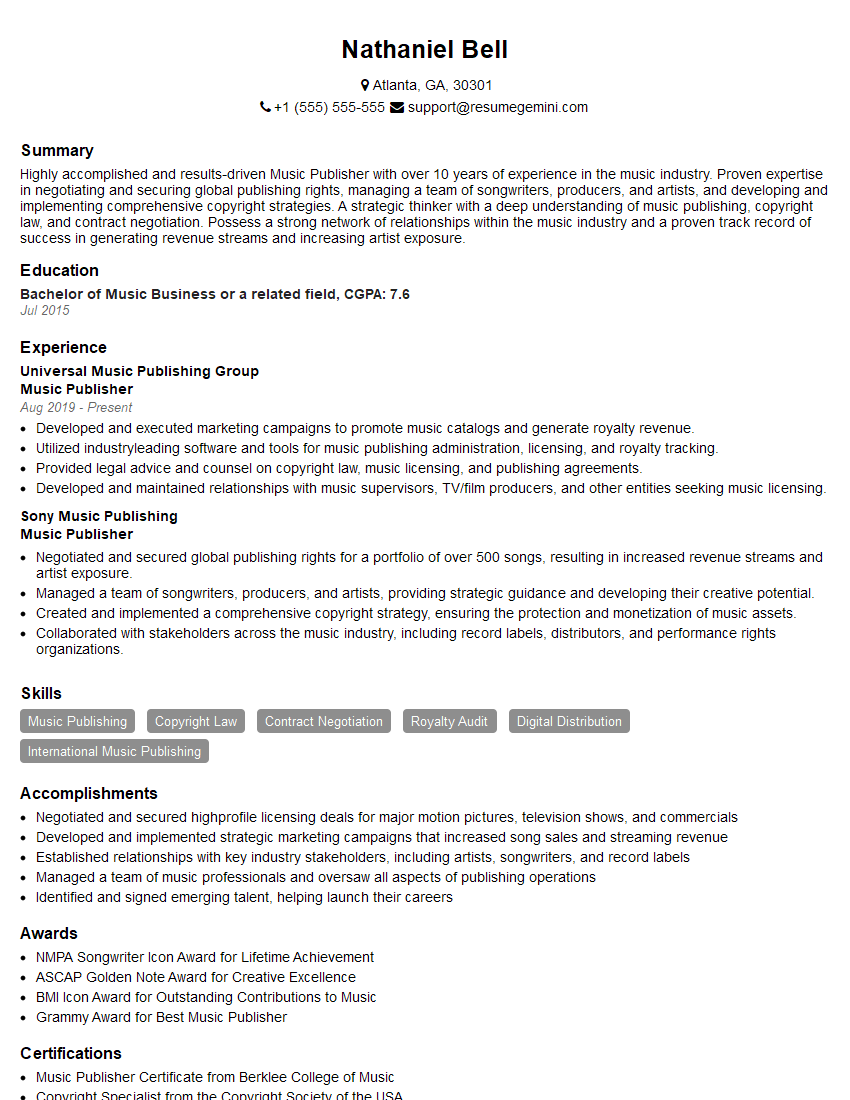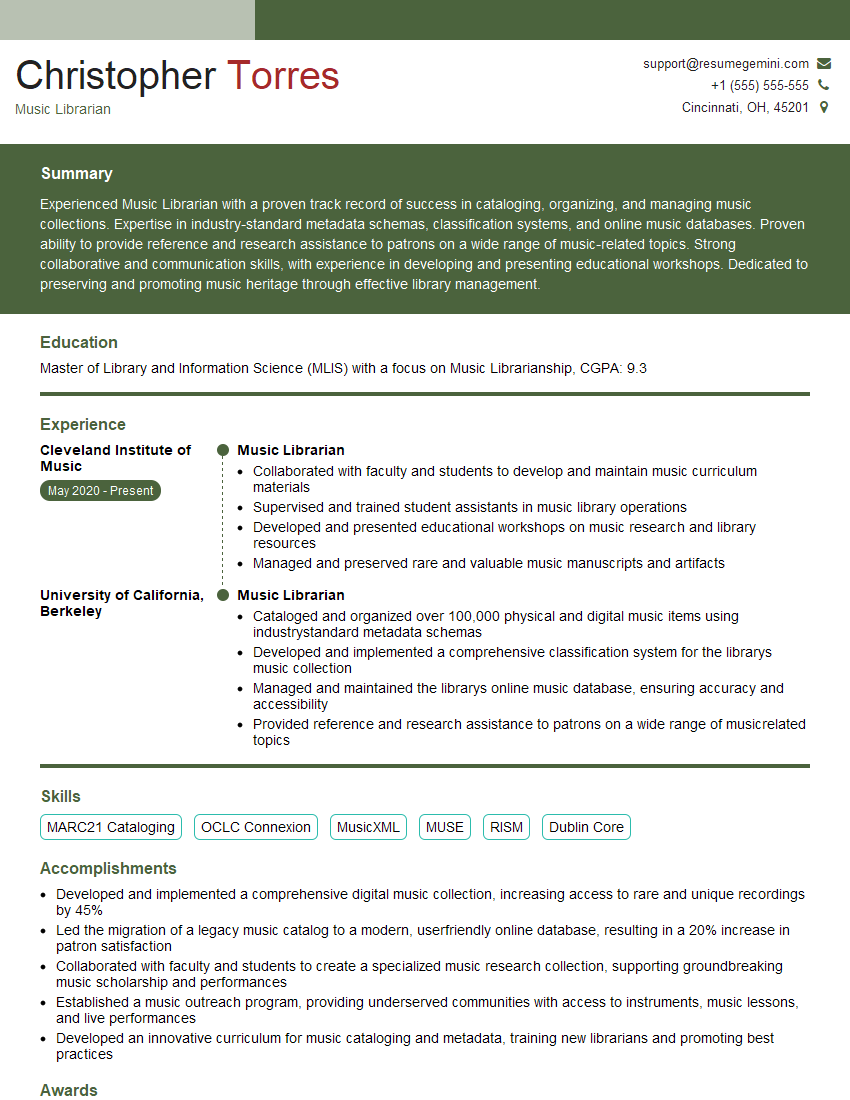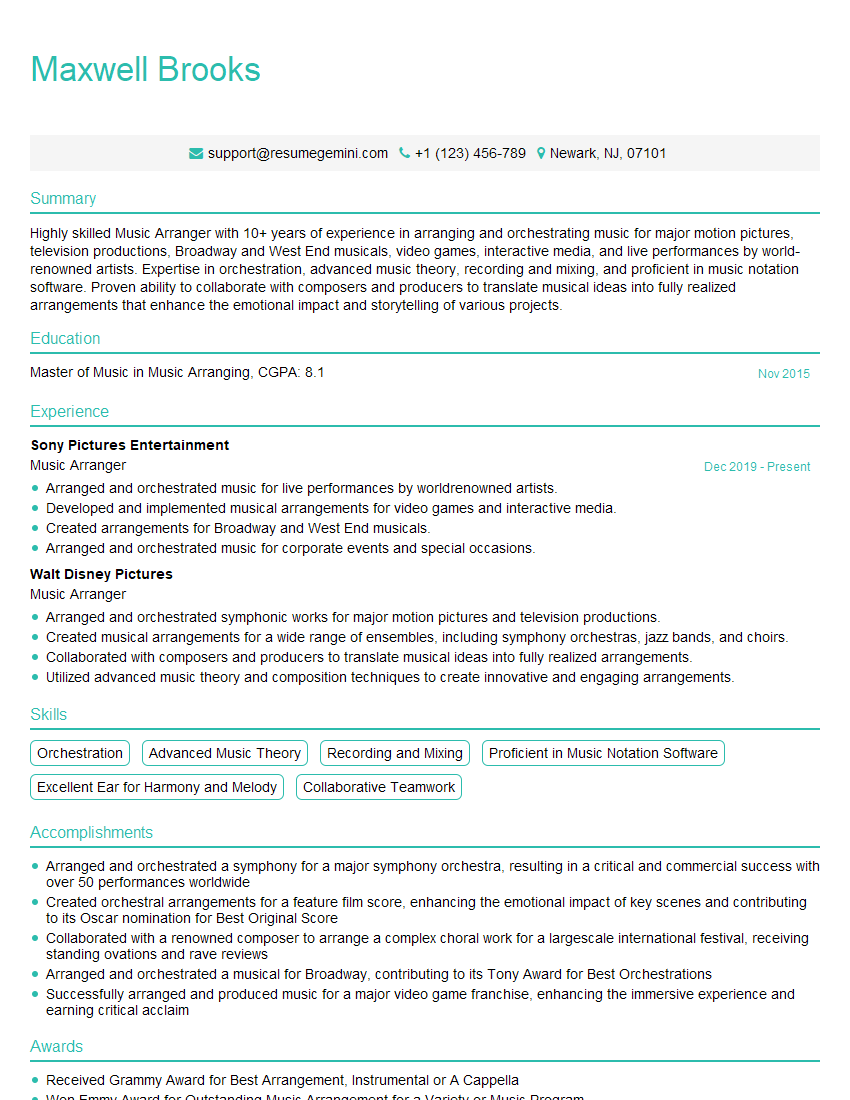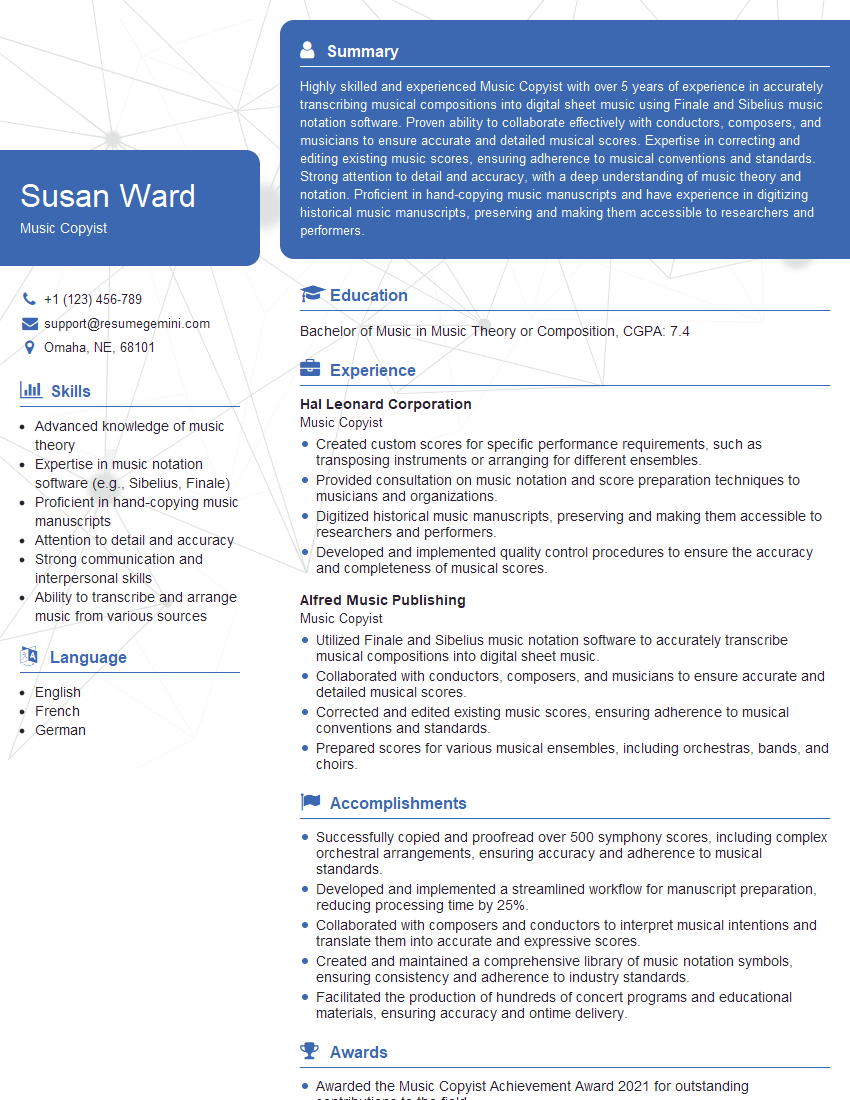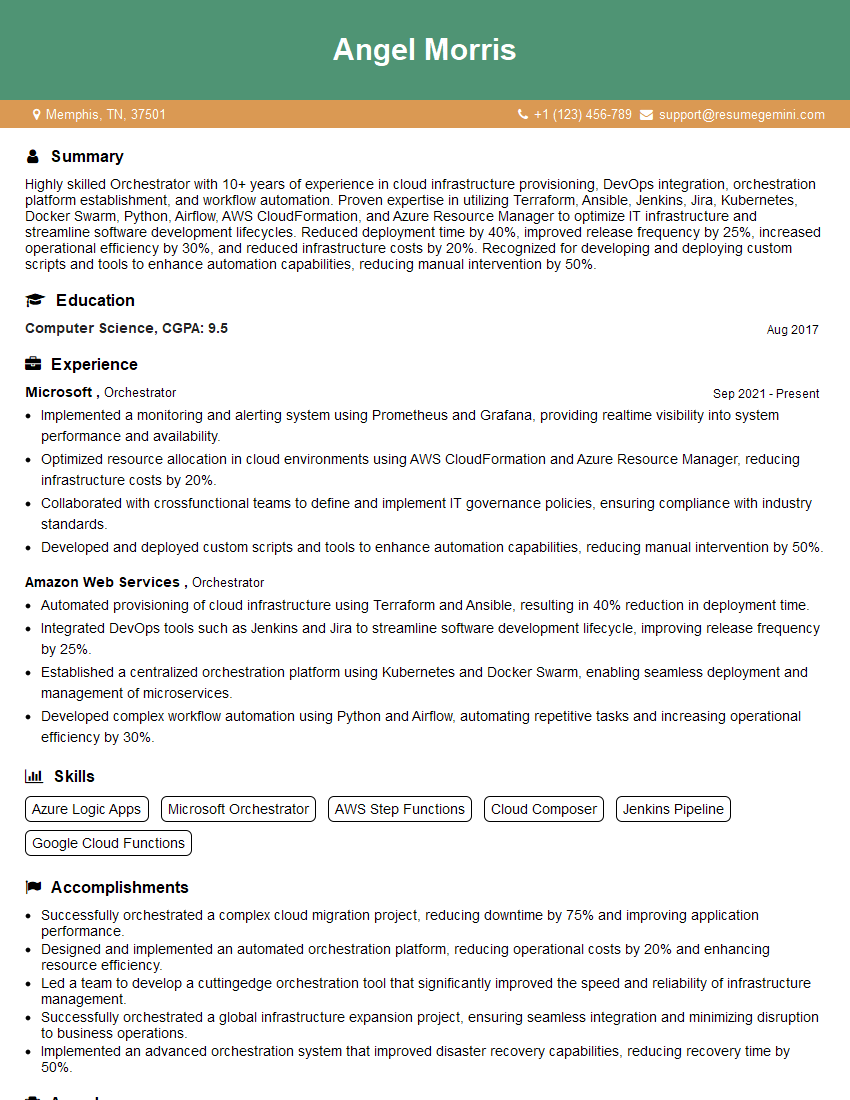The right preparation can turn an interview into an opportunity to showcase your expertise. This guide to Proficient in Music Notation interview questions is your ultimate resource, providing key insights and tips to help you ace your responses and stand out as a top candidate.
Questions Asked in Proficient in Music Notation Interview
Q 1. Explain the difference between a staff and a stave.
The terms “staff” and “stave” are often used interchangeably, particularly in American and British English respectively. However, a subtle distinction exists. ‘Staff’ is generally preferred in American English, referring to the five horizontal lines and the spaces between them on which musical notation is written. ‘Stave’ is the more traditional British English term for the same five-line system. Think of it like ‘elevator’ and ‘lift’ – they both mean the same thing, but their usage is regionally specific.
Q 2. Describe the various types of clefs and their uses.
Clefs are symbols placed at the beginning of a staff that indicate the pitch of notes written on the lines and spaces. Different clefs serve different musical ranges and instruments.
- Treble Clef (G Clef): The most common clef, used for higher-pitched instruments and voices like soprano, flute, and violin. The curl of the clef encircles the G line.
- Bass Clef (F Clef): Used for lower-pitched instruments and voices such as bassoon, cello, and bass. The two dots of the clef rest on the F lines.
- Alto Clef (C Clef): Less frequently used, this clef is found in older music and some choral arrangements, typically for alto voices. Its shape resembles a backwards ‘C’ and encircles the C line.
- Tenor Clef (C Clef): Another less common C clef, found in older music and some tenor vocal parts. It is a smaller version of the alto clef.
Choosing the correct clef is essential for accurately representing the pitch of the music. For example, a melody written in the treble clef would sound significantly higher if mistakenly notated in the bass clef.
Q 3. How do you notate dynamics and articulations?
Dynamics and articulations add expression and nuance to music. They indicate how loudly or softly a passage should be played (dynamics) and how individual notes or groups of notes should be performed (articulations).
- Dynamics: These are indicated by Italian terms.
p(piano) means soft,f(forte) means loud,mf(mezzo-forte) means moderately loud, andmp(mezzo-piano) means moderately soft. Gradual changes are shown usingcresc.(crescendo, gradually getting louder) anddecresc.ordim.(decrescendo or diminuendo, gradually getting softer). - Articulations: These control the attack and release of notes.
staccato(indicated by a dot above or below the note) means short and detached.legato(indicated by a slur connecting notes) means smooth and connected. Other articulations includemarcato(emphasized),tenuto(sustained), andaccent(a sharp accent on a single note).
Imagine a dramatic scene in a movie – the music swells (crescendo) to a powerful forte, then softens (decrescendo) to a gentle piano. The use of dynamics and articulations creates the emotional impact.
Q 4. Explain the purpose of key signatures and time signatures.
Key and time signatures provide essential information about the music’s harmonic and rhythmic framework.
- Key Signatures: These are sharps (#) or flats (♭) placed at the beginning of a staff, indicating the key (or tonality) of the piece. They tell us which notes are raised or lowered in relation to the main scale. For example, a key signature with two sharps indicates the key of D major or B minor.
- Time Signatures: These are numbers stacked vertically (e.g., 4/4, 3/4, 6/8). The top number indicates how many beats are in each measure (or bar), and the bottom number indicates the type of note that receives one beat. A 4/4 time signature means there are four quarter notes per measure.
Without key signatures, we’d have to constantly indicate accidental sharps and flats, making the music very cluttered and difficult to read. The time signature is crucial for understanding the rhythmic structure and pulse of the music.
Q 5. What are the standard symbols for repeats and codas?
Repeat and coda symbols are crucial for efficient notation, avoiding repetition of lengthy musical passages.
- Repeats: A double bar line with dots (
||: :||) indicates a section to be repeated. Sometimes, repeat signs (a ‘1’ or a ‘2’) can be used at the beginning and end of a section to indicate a repeat back to the beginning. - Codas: A coda (from the Italian for ‘tail’) is a passage that concludes a piece. A symbol (a curved line pointing downwards) at the end of a section designates the coda, leading the performer to jump to the coda marked by a curved line ending at the end of the piece, indicated by a similar symbol with a vertical line and a double barline.
Using these symbols reduces the amount of repetitive notation, and improves the clarity and readability of complex musical scores.
Q 6. How do you notate rests in different rhythmic values?
Rests represent silence in music. Their shapes vary according to their rhythmic value, mirroring the corresponding notes. For example:
- Whole Rest: A long rest that takes up the value of a whole note.
- Half Rest: A rest that takes up the value of a half note.
- Quarter Rest: A rest that takes up the value of a quarter note.
- Eighth Rest: A rest that takes up the value of an eighth note, and so on.
Understanding the duration of each rest is key to accurate interpretation and performance. A misplaced rest can significantly change the rhythm of the piece.
Q 7. Explain the difference between legato and staccato.
Legato and staccato are two contrasting articulations that significantly affect the phrasing and feel of a musical passage.
- Legato: Played smoothly and connected. Notes are played without any noticeable break between them, creating a flowing, singing sound. It’s often indicated by a slur connecting the notes.
- Staccato: Played short and detached. Each note is clearly separated from the next, creating a crisp, percussive effect. This is often indicated by a dot above or below each note.
Think of a legato phrase as a smooth, continuous wave, and a staccato phrase as a series of distinct, short pulses. The contrast between legato and staccato is essential for creating a wide range of musical expressions.
Q 8. How do you indicate slurs and ties?
Slurs and ties are both used to connect notes, but they serve different purposes. A slur connects notes that are played legato (smoothly and connected), often with a single bow stroke in string playing or a single breath in wind playing. A tie connects notes of the same pitch, indicating that they should be played as a single, longer note. Think of a slur as a smooth transition between different pitches and a tie as extending the duration of a single pitch.
Slurs are indicated by a curved line drawn above or below the notes.
Example:

Ties are shown as a curved line connecting the heads of the notes.
Example:

Q 9. How would you notate a trill and a mordent?
Trills and mordents are both ornaments, short melodic embellishments, that add expressiveness to a note. A trill involves the rapid alternation between a note and its neighboring note, usually a half or whole step above. A mordent is a rapid alternation between the main note and the note a half or whole step above or below it, but it begins on the main note.
A trill is notated with a ‘tr’ above or below the note, or sometimes with a wavy line over the note. The exact speed and range of the trill is often left to the performer’s interpretation, but more specific instructions can be added if needed.
Example:

A mordent is indicated by a ‘m’ (or sometimes a ‘pr’ for a ‘pralltriller’ which is similar to a mordent) above or below the note, or with a short, curved line starting from below the notehead and ending above it.
Example:

Q 10. Explain the use of accidentals and their placement.
Accidentals alter the pitch of a note from its natural diatonic position. They include sharps (#), flats (♭), and naturals (♮). Their placement is crucial for clarity and correct interpretation.
- Placement within a measure: Accidentals apply only to the note they immediately precede. An accidental affects the specific note only until the end of the measure.
- Accidental Consistency: If you have a note with the same letter name with the same accidental within the same measure, the repeated accidental can often be omitted.
- Key Signature vs. Accidentals: The key signature at the beginning of a piece sets the overall pitch context. Accidentals within the measure override the key signature for that specific note.
- Cautionary Accidentals: A cautionary accidental is placed just before a note that would otherwise be implied by the key signature, to avoid ambiguity. This is often used for enharmonic spellings.
Example: 
For instance, if a piece is in C major, and an F sharp appears, it should usually be explicitly notated. However, the F sharp may be omitted if immediately follows another F sharp in the same measure.
Q 11. Describe different types of note stems and their orientation.
Note stems are the short vertical lines attached to the note head. Their orientation indicates the pitch of the note in relation to the staff.
- Upward-pointing stems: Notes on or below the middle line of the staff usually have upward-pointing stems.
- Downward-pointing stems: Notes above the middle line of the staff usually have downward-pointing stems.
- Beams: Multiple notes of similar rhythmic values are often connected by beams, making the notation more efficient. These beams can connect up to eight notes.
- Stem direction for beamed notes: In a group of beamed notes, the stems are placed in the same direction.
Example: 
The systematic use of stem direction contributes greatly to the readability of music notation, especially in complex passages. Proper stem orientation is essential for accurate transcription and interpretation.
Q 12. How do you notate tuplets?
Tuplets are groups of notes played in the time normally occupied by a different number of notes. For example, a triplet is three notes played in the time of two. Tuplets are notated by placing a small number (indicating the number of notes in the tuplet) above or below the group of notes, often enclosed in a curved bracket.
Example: 
The number above the notes indicate how many notes will be played in the space allocated to a different number of notes. For example, if you have three notes played in the space of two, the 3 is written above the notes. This notation is essential for communicating irregular rhythmic groupings accurately.
Q 13. Explain the difference between a simple and compound meter.
Simple meter is characterized by a beat that is divided into two equal parts (binary division), such as 2/4, 3/4, or 4/4 time signatures. In simple meter, the top number represents the number of beats per measure, and the bottom number represents the type of note that receives one beat.
Compound meter has a beat that is divided into three equal parts (ternary division), such as 6/8, 9/8, or 12/8 time signatures. While the top number still signifies beats per measure, the beat itself is divided into three equal parts. A dotted note often receives one beat in compound meter.
The difference lies primarily in how the beat is subdivided: two vs. three. Understanding this difference is crucial for accurate rhythmic interpretation and performance.
Example: 
Q 14. How do you notate fermatas?
A fermata indicates a pause of indeterminate length, left to the performer’s judgment. It’s a small symbol resembling a ‘U’ placed above or below the note, indicating the lengthening of that note’s duration.
Example: 
Fermatas are used for expressive purposes, adding weight, emphasis, or emotional depth to a musical passage. The length of the pause is determined by musical context and artistic interpretation.
Q 15. What is the purpose of a cue?
A cue in music notation serves as a guide, typically a short musical excerpt, placed above or below the main score. Its purpose is to provide a visual reference for performers, especially when entering at a later point or playing a complex passage. Think of it like a roadmap snippet helping someone navigate to a specific location within a longer journey.
For instance, a violinist might have a cue showing the beginning of their entry in a concerto, even if their part doesn’t start until several measures later. This allows them to follow along and be prepared for their entrance without constantly scanning ahead in the full score.
Cues are particularly useful in orchestral scores, where numerous independent parts need to seamlessly blend together. They’re also important for soloists who join the ensemble partway through a piece, ensuring smooth transitions and confident performance.
Career Expert Tips:
- Ace those interviews! Prepare effectively by reviewing the Top 50 Most Common Interview Questions on ResumeGemini.
- Navigate your job search with confidence! Explore a wide range of Career Tips on ResumeGemini. Learn about common challenges and recommendations to overcome them.
- Craft the perfect resume! Master the Art of Resume Writing with ResumeGemini’s guide. Showcase your unique qualifications and achievements effectively.
- Don’t miss out on holiday savings! Build your dream resume with ResumeGemini’s ATS optimized templates.
Q 16. How do you handle text notation in your software?
Handling text notation in music notation software involves using dedicated tools to add articulations, dynamics, expression markings, and other textual information to the score. Most professional notation software provides robust text manipulation features. You can typically adjust font size, style, position, and even create custom text styles.
For instance, in Sibelius, you might use the ‘Text’ tool to add ‘cresc.’ above a phrase to indicate a gradual increase in volume. In Finale, you might use similar text entry functions to add rehearsal markings or composer notes. Accurate placement is crucial, ensuring readability without cluttering the score.
Beyond basic text entry, many software packages allow for more advanced features like text flows, allowing text to automatically adjust its position as you modify the surrounding musical notation. This is very helpful when dealing with long text instructions or multiple languages.
Q 17. How do you create a system break?
A system break creates a new system (or staff) of music on a new line. This is essential for controlling the visual layout of a score, preventing lines from becoming overly long or cluttered. It enhances readability and provides a better aesthetic presentation.
The method for creating a system break varies slightly between software. Generally, you’ll find a command or option within the layout or formatting menu. It might be labeled ‘System Break,’ ‘New System,’ or something similar. Some software will offer automatic system breaks based on pre-defined page margins and staff layouts. You might also manually adjust the position of system breaks to manage page turns effectively.
For example, in Dorico, you can use the ‘System Break’ command in the context menu. In Sibelius, you might drag and drop a system break marker onto the score. The key is to use system breaks strategically to maintain a clean and visually appealing layout, while preventing unnecessary page turns.
Q 18. How do you manage page turns and layout?
Managing page turns and layout in music notation is critical for creating a professional-looking score that’s easy for musicians to read. It goes beyond simply ensuring that each page is full; it’s about strategically placing system breaks, controlling spacing between staves, and optimizing the visual flow.
Many software packages offer automatic page layout features, but these often require manual adjustments for optimal results. You might need to manually adjust system breaks to avoid awkward page turns, such as a page ending mid-phrase or in the middle of a chord progression. You may also need to fine-tune spacing between systems or staves to ensure a balanced layout across pages.
Professional music engravers frequently use ‘page turn previews’ in their software to foresee how a score will appear before printing. This allows them to make necessary adjustments to optimize the layout and avoid visual disruptions. The goal is to create a score that’s not just accurate but also a pleasure to read and perform from.
Q 19. Describe your experience with Finale/Sibelius/Dorico/MuseScore.
I have extensive experience with Finale, Sibelius, and Dorico, having used each for various projects. Finale is known for its powerful features and extensive customization options, particularly useful for intricate scores. Sibelius is praised for its intuitive interface and efficient workflow, making it well-suited for large projects. Dorico is a relative newcomer but quickly gained popularity for its innovative features and elegant interface, making it excellent for managing complex orchestral scores.
I’ve found that each software has its own strengths and weaknesses. Finale’s power comes with a steeper learning curve, while Sibelius’s simplicity might lack the fine-grained control some users desire. Dorico strikes a nice balance between powerful features and user-friendliness. While I haven’t used MuseScore as extensively, I’m familiar with its capabilities as a free and open-source option, particularly suitable for simpler projects and education. The choice of software often depends on project requirements and personal preference. My proficiency allows me to adapt quickly to any of these.
Q 20. How do you ensure accuracy and consistency in your work?
Accuracy and consistency are paramount in music notation. To ensure this, I employ a multi-faceted approach. First, meticulous attention to detail is crucial during data entry. I carefully check every note, accidental, articulation, and dynamic marking. Second, I use the software’s built-in spell-checking and validation features to identify potential errors.
Third, I consistently apply style guidelines throughout the score. This includes using consistent font sizes, spacing, and formatting for all elements. Having clear style sheets (even if self-created) guides the process, promoting a unified look and feel. Finally, I conduct multiple proofreads of the final score, ideally with a fresh pair of eyes (collaboration is incredibly valuable here). This rigorous approach minimizes errors and ensures that the final product meets the highest standards of professional quality. Consistent style guides help to ensure not just accuracy, but a professional presentation.
Q 21. Explain your workflow for a typical music notation project.
My workflow for a typical music notation project starts with a thorough understanding of the musical source material, be it a handwritten score, audio recording, or a composer’s instructions. I then input the musical data into my chosen software (usually Dorico for its efficiency and power). I enter the notes, rests, and time signatures, meticulously checking for accuracy at each stage. Next, I add articulation markings, dynamics, and expression markings, applying a consistent style throughout.
After the basic musical data is entered, I address the layout. This involves strategically placing system breaks to optimize the visual appearance across pages. I pay particular attention to ensuring that page turns occur at musically logical points, rather than in the middle of a phrase. I check for spacing consistency and readability. Finally, I rigorously proofread the entire score, often using a print preview to catch any remaining errors or layout inconsistencies. I then provide a final version conforming to the client’s specific needs and professional standards.
Q 22. How do you handle revisions and edits in a music score?
Handling revisions in music notation requires a systematic approach. Think of it like editing a complex document; precision is paramount. I typically use version control within my notation software (like Sibelius or Dorico), allowing me to track changes and revert if necessary. For example, if a composer wants a rhythmic change in a specific section, I’d create a new version, clearly annotating the changes made, perhaps using a color-coded system for different revisions. This allows for easy comparison and ensures the composer can see exactly what adjustments have been made and easily approve or request further alterations. I also maintain meticulous notes detailing all revision requests, dates, and the actions taken. This rigorous approach minimizes errors and facilitates efficient collaboration.
Specific steps often involve creating separate layers for revisions within the software. This keeps the original score intact while allowing for experimentation and comparison. Once the composer approves a revision, I merge the changes into the main score, removing temporary layers and ensuring a clean, final product. This approach is crucial, especially in large-scale projects with numerous revisions.
Q 23. Describe your experience with music theory and its application to notation.
My understanding of music theory is fundamental to my notation work. It’s not just about knowing the rules; it’s about understanding the why behind them. For instance, comprehending voice leading—how melodic lines interact—allows me to notate complex contrapuntal textures in a clear and logical way. I utilize my theoretical knowledge to anticipate potential issues, such as parallel octaves or fifths, and resolve them proactively before they become significant problems. I’m proficient in all aspects of theory, including harmony, counterpoint, form, and analysis, enabling me to decipher even the most intricate scores and to interpret composer’s intentions accurately. This means I can accurately notate complex harmonies like extended chords or altered dominants, reflecting the subtleties of the composer’s expression.
A practical example: When a composer uses complex chord progressions, I need to understand the underlying harmonic function to notate them correctly, making sure the voicing is effective and the overall harmonic progression is clearly articulated in the score. My theoretical background informs decisions regarding key signatures, accidentals, and the overall layout of the score, resulting in a more accurate and aesthetically pleasing final product.
Q 24. How do you collaborate with composers or musicians on notation projects?
Collaboration is key. I establish clear communication channels from the outset, prioritizing regular feedback sessions with composers and musicians. I encourage open dialogue, ensuring I understand their vision completely before starting the notation process. This could involve reviewing sketches, audio recordings, or even detailed written descriptions. I frequently utilize video conferencing software for real-time feedback, allowing for immediate clarification of any uncertainties.
For instance, during a recent project with a contemporary composer, we held weekly meetings to discuss specific sections, resolving notational ambiguities in real time. This ensured the final score perfectly captured their musical intentions. The use of cloud-based sharing platforms allows both parties to simultaneously access and amend the score, ensuring a collaborative and efficient workflow. I always prioritize active listening and responsiveness, ensuring the score reflects the artist’s creative vision as accurately as possible.
Q 25. How familiar are you with various musical styles and their notational conventions?
My familiarity with musical styles spans centuries and genres. I’m comfortable with Baroque ornamentation (including trills, mordents, and appoggiaturas), Classical period phrasing and dynamics, Romantic era harmonic complexities, and the often unconventional notation of modern and contemporary music. I’ve worked on projects ranging from Bach’s counterpoint to avant-garde compositions with microtonal intervals and unconventional rhythmic structures.
This broad experience allows me to handle the nuances of different notational conventions with ease. For example, I understand the difference between the notation of a Baroque figured bass and a contemporary jazz chord chart. I can apply historical performance practices while also adapting to the diverse requirements of contemporary music notation.
Q 26. What are your methods for troubleshooting common notation issues?
Troubleshooting is an inherent part of the process. Common issues include accidental placement errors, inconsistencies in clefs or key signatures, and software glitches. My approach is systematic: I meticulously check the entire score for inconsistencies using the software’s built-in tools and my own visual inspection. For accidental issues, I perform a comprehensive review, paying close attention to context to ensure correct placement and avoid any errors in the harmonic progression.
If I encounter software glitches, I often consult online forums, documentation, and support resources before considering alternative software solutions or manual workarounds. For example, if a particularly complex passage creates software instability, I might simplify it temporarily for smoother processing and later reinstate the complexity, verifying stability each step of the way. In such situations, a strong understanding of music theory and notation principles is essential to identify and solve problems effectively.
Q 27. How do you ensure the legibility and clarity of your work?
Legibility and clarity are paramount. I maintain consistent spacing, utilize clear fonts, and employ appropriate sizing for both the score and the individual elements. This includes careful consideration of system breaks, ensuring the music flows naturally across the page without awkward breaks. I avoid unnecessary clutter, striving for a visually appealing and easily navigable score. I always adhere to the relevant engraving standards relevant to the style of music being notated.
For example, I might use different font weights to emphasize important melodic lines or to distinguish between different instrumental parts. I also use appropriate spacing to create visual breathing room, which enhances legibility. Ultimately, the aim is to create a score that is not only accurate but also a pleasure to read and perform from.
Q 28. Describe your experience using music notation software’s advanced features.
I’m highly proficient in advanced features of various music notation software, including Sibelius and Dorico. My skills go beyond basic entry; I utilize features like custom palettes for efficient notation of uncommon symbols or articulations specific to a given style. I routinely leverage the powerful score-layout tools for creating professional and aesthetically pleasing scores. I am comfortable with scripting and macro-creation for automated tasks, greatly enhancing my efficiency.
For example, I’ve used custom palettes in Sibelius to create a library of articulations specific to a particular composer’s style. In Dorico, I frequently employ its advanced engraving features to precisely control spacing, kerning, and overall layout, resulting in a refined and elegant final product. The mastery of these advanced features allows me to deliver high-quality scores efficiently and effectively.
Key Topics to Learn for Proficient in Music Notation Interview
- Fundamental Notation: Mastering clef signs, key signatures, time signatures, note values, and rests. Understand their practical application in reading and writing music.
- Rhythm and Meter: Demonstrate a thorough understanding of rhythmic complexity, syncopation, and metric modulation. Be prepared to analyze and explain rhythmic patterns in various musical contexts.
- Harmony and Voice Leading: Showcase your knowledge of chord progressions, voice leading techniques, and common harmonic structures. Be able to analyze simple and complex harmonic passages.
- Form and Structure: Understand common musical forms (e.g., sonata form, rondo, theme and variations) and be able to identify them in musical scores. Discuss how form impacts musical expression.
- Software Proficiency: Showcase your expertise in music notation software (e.g., Sibelius, Finale, Dorico). Be ready to discuss specific functionalities and workflows you’ve used.
- Transcription and Analysis: Demonstrate your ability to accurately transcribe musical pieces from audio or performance and analyze their musical elements.
- Orchestration and Scoring: If applicable, showcase your knowledge of instrument ranges, timbres, and techniques for effective orchestration and scoring.
- Problem-Solving: Prepare to discuss how you approach challenges in music notation, such as complex rhythmic passages or unusual harmonic structures. Highlight your analytical and creative problem-solving skills.
Next Steps
Proficiency in music notation is crucial for a wide range of musical careers, from composition and arranging to music education and publishing. Mastering these skills opens doors to exciting opportunities and career advancement. To maximize your chances of landing your dream role, a well-crafted resume is essential. An ATS-friendly resume ensures your application gets noticed by recruiters and hiring managers. We highly recommend leveraging ResumeGemini to build a professional and impactful resume that highlights your skills and experience effectively. ResumeGemini provides examples of resumes tailored specifically to professionals proficient in music notation, helping you present your qualifications in the best possible light.
Explore more articles
Users Rating of Our Blogs
Share Your Experience
We value your feedback! Please rate our content and share your thoughts (optional).
What Readers Say About Our Blog
Hello,
We found issues with your domain’s email setup that may be sending your messages to spam or blocking them completely. InboxShield Mini shows you how to fix it in minutes — no tech skills required.
Scan your domain now for details: https://inboxshield-mini.com/
— Adam @ InboxShield Mini
Reply STOP to unsubscribe
Hi, are you owner of interviewgemini.com? What if I told you I could help you find extra time in your schedule, reconnect with leads you didn’t even realize you missed, and bring in more “I want to work with you” conversations, without increasing your ad spend or hiring a full-time employee?
All with a flexible, budget-friendly service that could easily pay for itself. Sounds good?
Would it be nice to jump on a quick 10-minute call so I can show you exactly how we make this work?
Best,
Hapei
Marketing Director
Hey, I know you’re the owner of interviewgemini.com. I’ll be quick.
Fundraising for your business is tough and time-consuming. We make it easier by guaranteeing two private investor meetings each month, for six months. No demos, no pitch events – just direct introductions to active investors matched to your startup.
If youR17;re raising, this could help you build real momentum. Want me to send more info?
Hi, I represent an SEO company that specialises in getting you AI citations and higher rankings on Google. I’d like to offer you a 100% free SEO audit for your website. Would you be interested?
Hi, I represent an SEO company that specialises in getting you AI citations and higher rankings on Google. I’d like to offer you a 100% free SEO audit for your website. Would you be interested?
good
